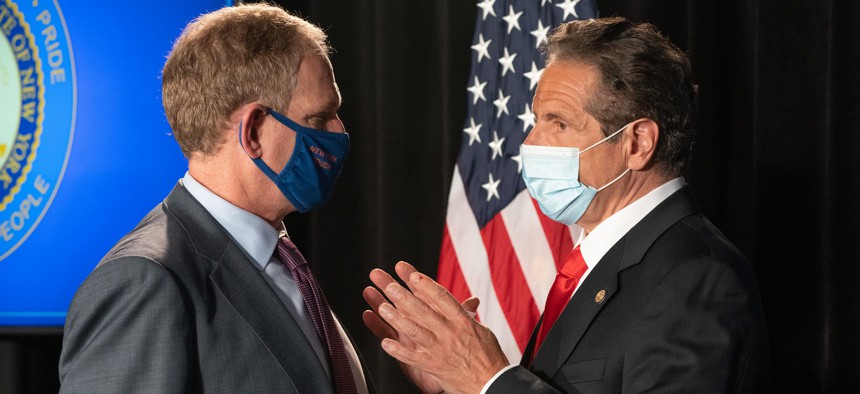The Metropolitan Transportation Authority’s leadership saga ended with a fizzle last week, after Janno Lieber was named as the agency’s acting chair and CEO. Despite attempts by Gov. Andrew Cuomo to divide the role into two jobs, the state Legislature never approved a bill to do so and time ran out on the governor’s end-of-session play for power before former MTA head Pat Foye stepped down.
The drama began in the waning days of this year’s legislative session as lawmakers rushed to reach deals before they broke for the year. The state Senate approved many Cuomo appointees, including his contentious pick for the state Court of Appeals, Madeline Singas. On the docket, in theory, should have been Cuomo’s nominee to lead the MTA with Foye’s impending exit on July 30. But on the evening of June 7, just days before the end of the session, state Sen. Diane Savino and Assembly Member Amy Paulin introduced legislation to split the MTA chair and CEO positions. Under this structure, the governor would have had the sole authority to appoint the CEO – he planned to put Lieber in that role – but would have needed state Senate approval for the chair, which would have been Sarah Feinberg.
The proposal was panned by many transit advocates, good-government groups, lawmakers and at least one transit union leader, and at first, it didn’t seem to be going anywhere. And on June 9, the bill sponsors said the legislation was dead due to a lack of support. But after a flurry of negotiations, a deal supposedly had been made for the final day of the session on June 10. Cuomo agreed to make both positions subject to state Senate approval, and the Senate supposedly would reconvene to approve Lieber and Feinberg a few weeks later. As part of the agreement, Cuomo reportedly agreed to issue a message of necessity for the Clean Slate Act, a priority for criminal justice advocates that would have wiped clean the criminal records of many in the state.
What had seemed like a done deal fell through at the last minute, with neither of the bills being approved. Although the Assembly passed the MTA bill before leaving for the year, the state Senate didn’t. “The Senate's decision to reject the governor’s last-minute proposal to split the position was in the best interest of both the legislature and MTA riders,” said Rachael Fauss, senior research analyst at Reinvent Albany. When announcing Lieber as the acting MTA head, Cuomo said that the state Senate “has yet to act” on his legislation, and a spokesperson confirmed that the governor is still pushing for the bill to split the role. Feinberg, who departed from her position as interim New York City Transit president, said she would return to the MTA if she were nominated for the chair position. But a spokesperson for the state Senate Democrats said that nothing had changed between the end of the session and now regarding the legislation, indicating that Cuomo’s attempted restructuring of the MTA is still on the fast track to nowhere.
The MTA leadership saga is the latest in a growing number of examples of how the scandals and investigations surrounding Cuomo are diminishing his influence. And this time, this loss of influence comes in an arena where he has immense control. “While the Governor controls the operations of the MTA, he does not unilaterally control the laws that affect it,” Fauss said. “That requires the sign-off of the Legislature, which is increasingly less willing to rubber-stamp his whims.”
Before this recent example, recreational marijuana legalization happened outside the budget, with legislative leaders largely driving the negotiations. Cuomo was also notably absent from the budget process itself, with a historically large spending plan that included new tax hikes and big wins for the Legislature, despite the immense power the governor holds during budget season. He also stayed out of the end of session deal-making, with the exception of the MTA legislation, claiming that he had already achieved his goals for the year.
Traditionally, Cuomo has been able to exert his influence over the MTA, an agency he effectively controls. He appointed – with Senate approval, of course – the leader of the MTA, who generally takes their cues from the governor. Cuomo’s appointees to the MTA board also exert incredible influence over its decision-making. Just on Monday, Cuomo – not acting MTA Chair and CEO Janno Lieber – first announced the new vaccine and testing mandate for MTA employees.
Even outside his official capacity, Cuomo shapes the MTA’s operations. Although both parties publicly denied reports of tension during his tenure, former New York City Transit President Andy Byford later said that he felt undermined by Cuomo’s micromanaging, making the job “intolerable” and resulting in his exit from the agency despite his widespread popularity. In 2019, Cuomo was able to work with the state Legislature to pass congestion pricing to help fund the MTA (something transit advocates now accuse him of delaying) and legislation that required the agency to hire a consulting firm to develop a restructuring plan. Ultimately, the proposal for restructuring got panned by transit advocates as well, but it still was approved.
This year, Cuomo’s attempt to expand his MTA powers fell flat, a dramatic shift from how he has been able to flex his influence in the past. He still was able to appoint Lieber to the leadership position in an acting fashion, and there’s no reason to think that Lieber won’t get the Senate’s approval, but Cuomo’s influence certainly has waned ahead of a crucial reelection fight for a fourth term next year.


